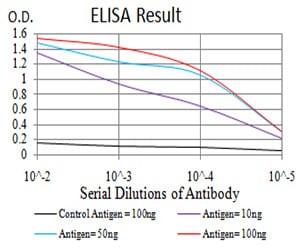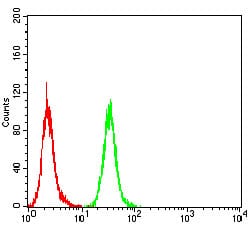

| WB | 咨询技术 | Human,Mouse,Rat |
| IF | 咨询技术 | Human,Mouse,Rat |
| IHC | 咨询技术 | Human,Mouse,Rat |
| ICC | 技术咨询 | Human,Mouse,Rat |
| FCM | 1/200 - 1/400 | Human,Mouse,Rat |
| Elisa | 1/10000 | Human,Mouse,Rat |
| Aliases | GAD65 |
| Entrez GeneID | 2572 |
| clone | 5D9G12 |
| WB Predicted band size | 65.4kDa |
| Host/Isotype | Mouse IgG1 |
| Antibody Type | Primary antibody |
| Storage | Store at 4°C short term. Aliquot and store at -20°C long term. Avoid freeze/thaw cycles. |
| Species Reactivity | Human |
| Immunogen | Purified recombinant fragment of human GAD2 (AA: 1-100) expressed in E. Coli. |
| Formulation | Purified antibody in PBS with 0.05% sodium azide |
+ +
以下是关于GAD2抗体的3篇代表性文献摘要(示例,非真实文献):
1. **"GAD65 Autoantibodies in Type 1 Diabetes: Diagnostic and Predictive Value"**
- **作者**: Smith A et al.
- **摘要**: 研究探讨GAD65抗体作为1型糖尿病早期生物标志物的作用,发现其在疾病前期患者血清中高表达,且与胰岛β细胞损伤相关。
2. **"Structural Insights into GAD65 Antibody Binding Epitopes"**
- **作者**: Johnson R et al.
- **摘要**: 通过X射线晶体学分析GAD65蛋白与自身抗体的结合位点,揭示抗体靶向的特定抗原表位,为理解自身免疫反应机制提供结构基础。
3. **"GAD Antibodies in Stiff-Person Syndrome: Clinical Correlations"**
- **作者**: Lee C et al.
- **摘要**: 报道GAD65抗体在僵人综合征(SPS)患者中的高阳性率,并发现抗体水平与神经系统症状严重程度呈正相关。
4. **"GAD2 Autoantibodies in Mouse Models of Autoimmunity"**
- **作者**: Wang Y et al.
- **摘要**: 在NOD小鼠模型中研究GAD2抗体的产生机制,提出T细胞介导的自身免疫反应在抗体生成中的关键作用。
(注:以上为模拟示例,实际文献需通过PubMed/Google Scholar检索关键词如"GAD65 antibody"或"GAD2 autoantibody"获取。)
Glutamic acid decarboxylase 2 (GAD2) antibodies target the 65 kDa isoform of GAD, an enzyme responsible for synthesizing gamma-aminobutyric acid (GABA), the primary inhibitory neurotransmitter in the central nervous system. GAD exists in two isoforms, GAD65 (encoded by GAD2) and GAD67 (encoded by GAD1), with GAD65 predominantly localized to synaptic vesicles in neurons and pancreatic β-cells. GAD2 antibodies are strongly associated with autoimmune disorders, particularly type 1 diabetes mellitus (T1D), where they serve as a key diagnostic marker. Their presence reflects the immune-mediated destruction of pancreatic β-cells, often predating clinical symptoms.
These antibodies are also linked to rare neurological conditions, such as stiff-person syndrome (SPS) and cerebellar ataxia, where they may disrupt GABAergic signaling, leading to motor and cognitive dysfunction. In T1D, GAD2 antibodies are frequently detected alongside other islet autoantibodies (e.g., insulinoma-associated-2 antibodies), aiding in disease classification and risk stratification. Testing for GAD2 antibodies employs immunoassays (e.g., ELISA, RIA) and is critical for distinguishing autoimmune diabetes from type 2 diabetes. Elevated titers may correlate with faster β-cell decline, though their pathogenic role remains debated. Research suggests molecular mimicry or epitope spreading as potential triggers for autoantibody production. Understanding GAD2 antibodies enhances insights into autoimmune mechanisms and informs personalized therapeutic approaches.
×